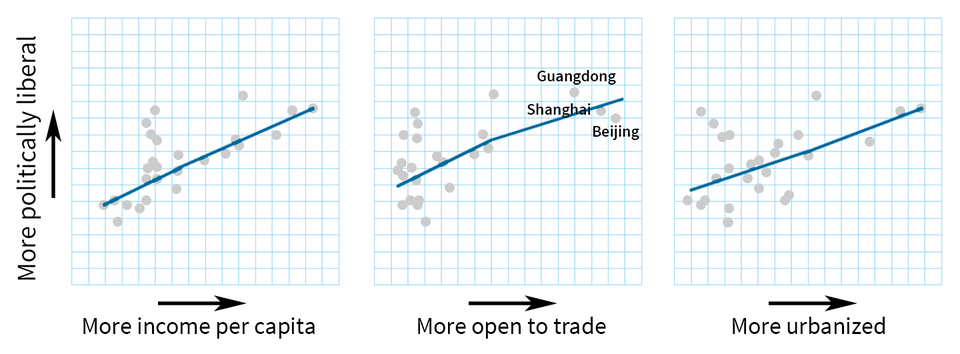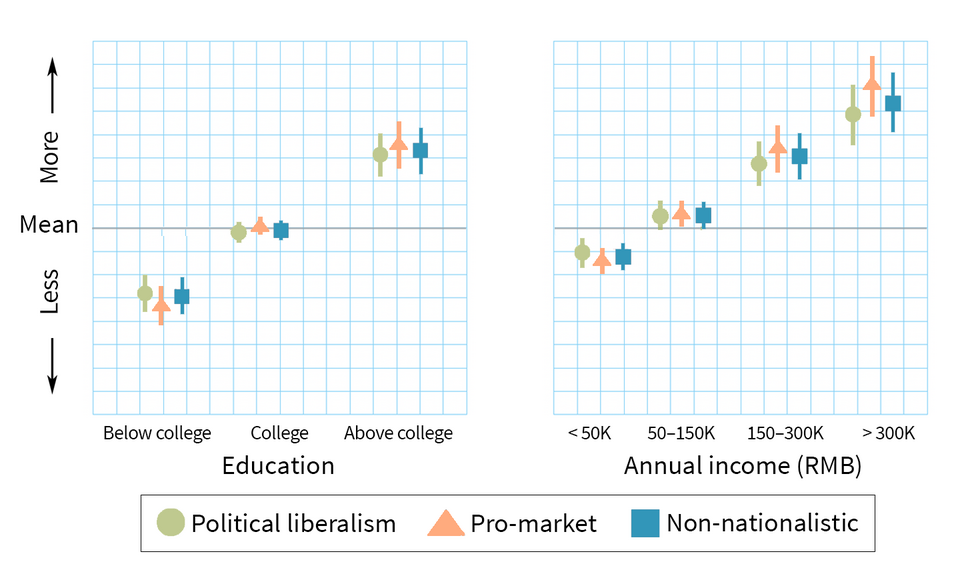Is there a Political “Left” or “Right” in China? Charting China’s Ideological Spectrum
Is there a Political “Left” or “Right” in China? Charting China’s Ideological Spectrum [ 4 min read ]
Insights
- Ideological positions in China do not align neatly along a left-right spectrum.
- Instead, they loosely cluster around preferences for pro-market policies versus state intervention in the economy, more versus less democracy in government, and more versus less nationalistic sentiment.
- While stable over time, this clustering is looser than in competitive democracies and fails to align along pro- or anti-regime positions.
Source Publications:
Jennifer Pan and Yiqing Xu (2018). China’s Ideological Spectrum. The Journal of Politics.
Understanding the ideological spectrum in China can shed light on public support or opposition to policies of the central government and highlight possible constraints on regime behavior. However, in part due to the difficulty of collecting public opinion data in China, little research has been done to determine the ideological spectrum there. Is there a "left" or a "right" in China? What positions are correlated with what regional or individual characteristics?
The data. Nearly 500,000 individuals participated in an online survey from January 2012 and December 2014 that included issues typically excluded from China’s nationally representative surveys due to their sensitivity. From these responses, researchers developed a first-of-its-kind sample of 10,000 observations that are broadly representative of China’s ideological spectrum. Additional surveys in 2018 and 2019–2020 were used to test the reliability of the sample and the stability of ideological positions over time.
Ideological positions cluster along political, economic, and nationalistic spectrums. Researchers identified three key dimensions around which ideas and attitudes cluster: 1) preference for authoritarian institutions versus preference for democratic institutions; 2) preference for state intervention in the economy and traditional social values versus preference for pro-market policies and non-traditional social values; and 3) preference for greater nationalism versus less nationalism.
Positions at either end of these dimensions are correlated. Preference for authoritarian institutions, for example, is correlated with preference for state intervention in the economy, traditional values, and greater nationalism. Preferences are also stable over time. Responses to the same questions and to questions in the same dimension are highly correlated when respondents are asked the same questions a month apart and also a year apart.
Data indicate that wealthier, urban, and more highly educated Chinese are less nationalistic, tend to prefer additional market liberalization and democratizing political reforms, and do not endorse traditional social norms. Meanwhile, poorer, less educated citizens are more nationalistic and tend to support authoritarian rule, state intervention, and traditional social values.
Correlation between political liberalism and provincial characteristics

Ideological positions reflect a split between those who have benefited more or less from China's market reforms. Those who have benefited from China's market-oriented reforms tend to prefer policies that further liberalization and democratization, whereas those who remain relatively disadvantaged are likely to support more conservative positions, such as wealth redistribution and authoritarian rule.
For example, individuals from regions such as Guangdong, Shanghai, and Beijing with higher levels of economic development, trade openness, and urbanization on average lean toward the liberal, pro-market/non-traditional, and non-nationalistic end of the spectrum. In contrast, respondents from poorer regions lean on average toward the conservative, anti-market/traditional, and more strongly nationalistic end of the spectrum. At the individual level, those with liberal, pro-market/non-traditional, and non-nationalistic clustering of preferences are more likely to have higher levels of income and education.
Correlation between ideological positions and personal characteristics

Correlation between individual characteristics and ideological positions are weaker than in many democratic societies. The analysis indicates that while political and economic preferences in China are grouped along known debates and reflect familiar political, economic, and ideological splits, their correlations are relatively weak, particularly in comparison to competitive democracies like the U.S., where tighter clustering of views reflects more polarized partisan divides.
China's ideological spectrum does not align along clear pro-regime or anti-regime positions. Even though regions or individuals with more education and wealth may prefer changes to China's current political system, for example, these preferences may not lead to opposition if the CCP maintains the trajectory of a market-based economy. This is because those who espouse liberal political values would still support the CCP as long as it generally maintains market-oriented economic policies. Conversely, those who oppose economic reforms would likely continue to uphold the CCP for its authoritarian political orientation. Because China's multidimensional ideological spectrum does not conform to pro-regime and anti-regime factions, it is unlikely that an organized opposition to the regime will emerge.
